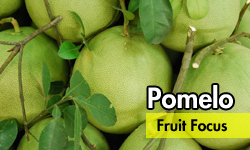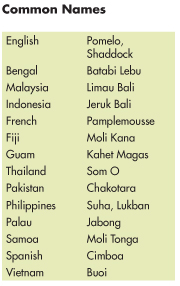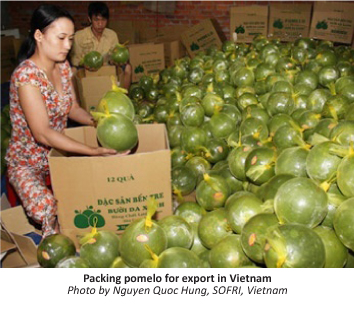 Pomelo (Citrus grandis), the biggest citrus in the world, has a seductingly sweet and deliciously tart taste. Originating in Southest Asia, legend has it that British seafarer Captain Shaddock brought pomelo to the Caribbean that led to its english name “shaddock.” It was then crossbred with sweet orange that gave rise to the modern grapefruit. Now, the global consumption for pomelo is steadily increasing but is still low compared to other major citruses.
Pomelo (Citrus grandis), the biggest citrus in the world, has a seductingly sweet and deliciously tart taste. Originating in Southest Asia, legend has it that British seafarer Captain Shaddock brought pomelo to the Caribbean that led to its english name “shaddock.” It was then crossbred with sweet orange that gave rise to the modern grapefruit. Now, the global consumption for pomelo is steadily increasing but is still low compared to other major citruses.
Pomelo is native to Southeast Asia and is now grown in countries including Malaysia, Indonesia, China, Japan, India, Fiji, Philippines, Vietnam, and Thailand. Since its introduction to China around 100 B.C., pomelo has been cultivated as a traditional fruit crop for the Lunar New Year.
Plant Description
The pomelo tree reaches 5-15 m tall, with a 10-30 cm crooked trunk. Its branches are low, irregular and densely soft, which are short when young. More than 70% the roots are in the top meter of soil. Leaves are compound and grow alternately with an elliptic shape. Like other citruses, the off-white large flowers are fragrant and single. In optimal conditions, pomelo bears flowers 4 times a year.
Fruit Description
Pomelo is the biggest citrus fruit, reaching 10-30 cm wide and weighing 1-3 kg. It can be nearly round, oblate, or pear-shaped.
The rind is thick and leathery, which contains oil glands. It is recommended to peel the skin with a knife as the 1.23-cm thick rind may be difficult to peel by hand. White mesocarp covers the edible flesh, and is divided into many sections.
The pulp is juicy and the color varies from greenish-yellow, pale-yellow, pink, or red. The pulp can be sweet, bland, or tangy but not as acidic as other citrus.
Pomelo seeds are large, plump, pale yellow-white, flattened, and angular. They are unique among its citrus cousins for having a single embryo. Others are polyembryonic.
Common Varieties
Honey Pomelo is grown in Pinghe, China. It is seedless and sweet with semi-transparent flesh. Its skin color varies from light green to lemon yellow.
Tambun White (PO52) is commercially planted by Malaysian farmers. It is seedless and has a high juice content, weighing 1.4-1.7 kg. The skin is light green to light yellow. The fruit is sweet and popular among locals.
Da Xanh is a green-skinned and round pomelo from Vietnam. Fruit weighs 1.0-1.5 kg with juicy pinkish red flesh when ripe. The pulp contains sweet juice of 11-12% brix.
Siamese Sweet is an acidless, sweet pomelo from Thailand. It has white pulp with large, crisp, non-juicy sacs easily separating from each other. Its flavor is mild but faintly bitter. This variety has been used in many citrus development programmes.
Magallanes is a popular cultivar grown in the Philippines. Fruits are small- to medium-size, weighing 0.7-0.9 kg. Flesh is pink when ripe with brix content of 9%. It is consumed domestically.
Propagation
Pomelo can be propagated by many methods including seeds, cuttings, air-layering, grafting, and marcotting.
Commercially, it is commonly propagated by grafting an individual bud of a selected variety onto a rootstock seedling or by air-layering method.
Cultivars reproduced by seed are considered inferior, not uniform and takes a long time to produce fruit.
Fertilization
Fertilizers containing N and K are best applied in small applications several times over the course of the year. In addition to inorganic fertilizers, well composted manures or other organic fertilizers can be added to the planting hole and spread around the base of the tree occasionally.
Pruning
Once the tree has reached the desired height, annual pruning may be required to maintain the height, thin the growth, and promote prolific fruiting. Pruning should be done when trees are young to establish the basic shape and continued as trees mature. Pruning is conducted to either encourage growth (thinning) or reduce tree size (heading back).
Pest and Diseases
For more plant health information, including diagnostic resources, best-practice pest management advice and plant clinic data analysis for targeted crop protection, visit CABI’s Plantwise Knowledge Bank.
Compared to other citrus, pomelos are relatively tolerant to most pests and diseases.
Leaf miner (Phyllocnistus citrella), leaf-eating caterpillar (Papilio demoleus, P. polytes), fruit-borer caterpillar (Citripestis sp.), scale insects (Chloropulvinaria psidii), red mites (Panonychus citri), fruit flies (Bactrocera dorsalis), nematodes (Pratylenchus sp., Tylenchulus semipenetrans, and Meloidogyne sp.) and rats (Rattus sp.) are the common pests for pomelo.
Bacterial canker (Xanthomonas campestris p.v. citri) is common disease on citruses, although not a serious treath to pomelo. Root rot (Fusarium solani, Phytophthora sp. and Pythium sp.), gummosis (Phytophthora nicitianae var. parasitica, P. citropthora, P. palmivora) and brown rot (Phytophthora sp.) are common diseases of pomelo.
Physiological disorders include fruit cracking from boron deficiency and moisture imbalances.
Harvesting
Fruits for marketing are generally harvested when they are just beginning to turn color. In Malaysia, the fruit matures in about 5.5 months from flowering. When the weather is hot throughout the fruiting season, the fruit may ripen about a week earlier. If the weather is hazy or cloudy, with frequent rain during the fruiting season, maturity can be delayed to over six months. The dull skin of the unripe fruit brightens upon ripening, as the oil glands in the rind become more prominent and shiny.
Market
Pomelo fruit is eaten fresh or processed into juice. Its nutritional value is slightly better compared with grapefruit, but less so with orange.
The fruit can remain at room temperature for up to two months. It can maintain its freshness for few months when stored in the fruit drawer of the refrigerator. The optimum storage temperature for pomelo is about 12°C.
Food Value
Pomelo is an excellent source of vitamin C and a good source of folate, potassium, phosphorus, vitamin A, and calcium.
Other Uses
Traditional Medicine: The Chinese believe that pomelo fortifies the lungs and the spleen. It is also believed that the fruit can reduce abdominal pains, oedema, and phlegm. The leaves are boiled into a lotion and applied on swellings and ulcers. Decoctions of the leaves, flowers and rind is believed to alleviate epilepsy, chorea, and convulsive coughing.




Why do my Pomelos crack open before even ripening on the tree? Each season I get about 50 pomelos from this one tree but all the fruits are cracking and not ripening thereafter. Please advise.
Why do my Pomelos crack open before even ripening on the tree? Each season I get about 50 pomelos from this one tree but all the fruits are cracking and not ripening thereafter. Please advise.Should I water it more. I give a full bucket of water every morning.